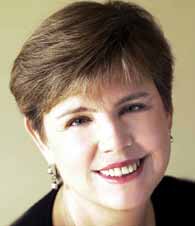|
Executive Interviews: Interview with Sally Helgesen on 21st Century Organization
December 2007
-
By Dr. Nagendra V Chowdary
 Sally Helgesen
Sally Helgesen Internationally acclaimed Author, Speaker, and Leadership Development Consultant. 
One author and five very good
books; The Female Advantage:
Womens Ways of Leadership, The Web
of Inclusion: Building an Organization
for Everyone, Thriving in 24/7: Six
Strategies for Taming the NewWorld of
Work, Everyday Revolutionaries:
Working Women and the
Transformation of American Life and
Wildcatters: A Story of Texans, Oil and
Money. Which has been the most
satisfying project of all these?
The Web of Inclusion has been most
satisfying because it has seemed the
most timeless, and has proposed an
approach to building organizations
that seem to resonate around the
world in non profits, businesses,
religious institutions, government
agencies, military organizations, and
health care companies.
|
|
-
What according to you are the three
most important changes that have
altered theway business is carried out
across the globe in the last decade?
How do you think companies have
responded to these changes?Are there
any good examples of companies that
have adapted effectively to these
changes?
Most important changes are cheap,
fast, highly integrated networked
technologies of communication and
distribution; new demographics that
reflect a highly diversework force and
customer base; and an economic
model that values human knowledge
far above capital goods. Most
companies understand these changes
but are in the early stages of either
adapting to or reacting against aworld
transformed. -
If you have to point out similar
changes in the organizational front,
whatwould those be?What have been
the triggers for such changes?
Organizations are trying to develop
models that accommodate and
leverage the changes noted above.
This requires new models the web
of inclusion is one. I think one big
challenge for organizations is figuring
out when the decision making needs
to be centralized and when it needs to
be distributed. Technology puts
information and power, that were
formerly held by tight organizational
structures, into the hands of
individuals. This makes senior
executives very nervous. I often hear
them saying, "we are empowering our
people to do this, that or the other."
And I think, you're not empowering
them, the technology is, and you are
just trying to figure out how not to get
in the way! -
In "Everyday Revolutionaries:
Working Women and the
Transformation of American Life", you
point out that you have uncovered
five major trends that are reshaping
our organizations and communities.
What are those five trends? Why
would you say they are the result only
of women entering the workforce?
The five major trends are:
- Industrial era boundaries
(between work and home, men
and women, boss and employee,
service and product, etc.) are
breaking down
- Change has become a constant,
not a rarity
- The niche rules the marketplace
- Job shifting requires a portfolio
approach to careers
- Balance is no longer just a
women's issue.
Obviously, women have been at
the forefront of breaking down
boundaries that kept the genders
separate in the industrial era, and
have brought the issue of balance to
the fore. Women change jobs more,
and so are on the front edge of the
portfolio approach. The niche has
been redefined by womens presence
as customers, consumers and
employees. The constancy of change
is driven by the technologymore than
by the changing demographics. -
Since Peter Drucker wrote his
seminal work, "The Concept of
Corporation" in 1946 after his study at
General Motors, organizations have
undergone a metamorphosis in terms
of the structure, the defining
responsibilities of organizations,
expectations from organizations, etc.
What does the 21st century
organization signify to you? What is
your ideal organization in the coming
decades?
Virtuality, partnerships, borderless
ness, and instability will necessarily
define the organizations that thrive in
the 21st century. The big challengewill
be building sustainability in
organizations, in the culture, in
human life and expectations in an
environment that is constantly being
transformed by the unexpected. -
What is organizational
effectiveness? Has its connotation
undergone any change over the years,
across the industries? How should
this be measured? What are the
yardsticks for measuring
organizational effectiveness?
This is not an areawhere I havemuch
expertise. But I am interested in
organizations that effectively create
sustainable cultures in the midst of
constant change. The effective
organization today is driven by a
strong and coherent vision, and
disciplined decision making an
imperative in a world of endless
choice. Berkshire Hathaway, Warren
Buffett's investment company comes
tomind. I will be eager to watch how the Bill and Melinda Gates Foundation
fares. British Petroleum was doing a
great job of this before it came to grief.
Johnson & Johnson has done an
exceptional job. Will HP prove
resilient? We'll have to see.
1.
Human Resource and Organization Behavior Case Studies
2. ICMR
Case Collection
3.
Case Study Volumes
|
